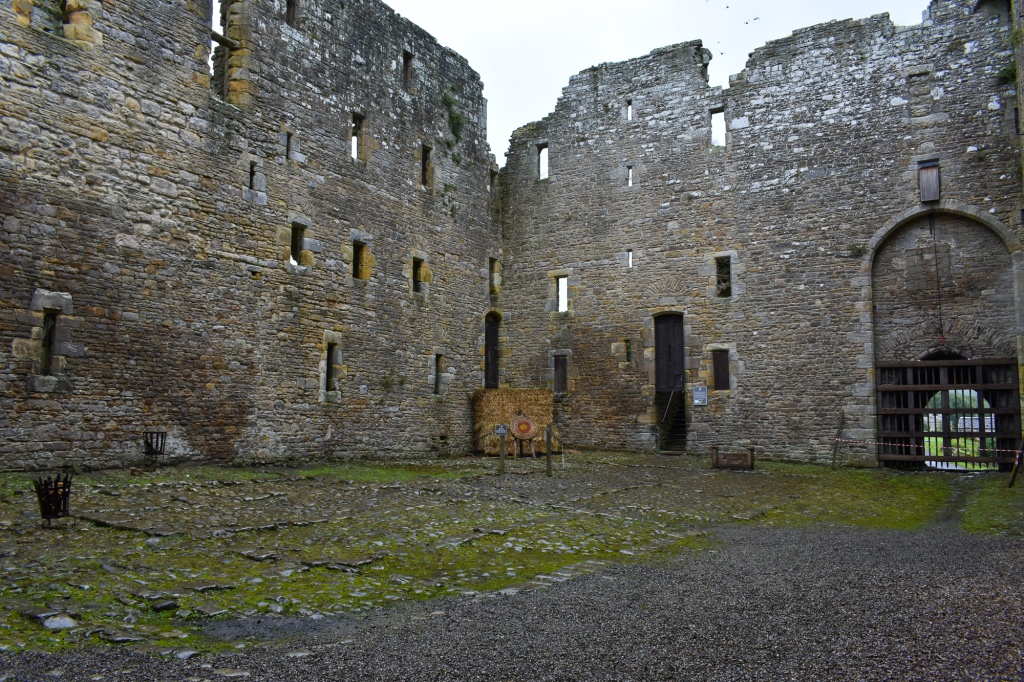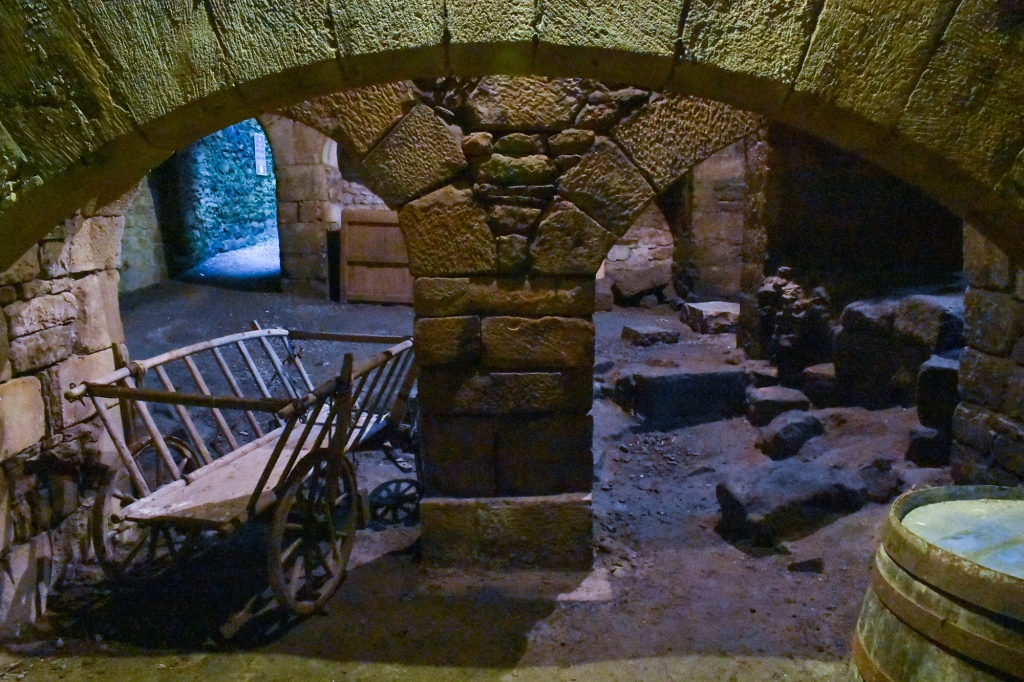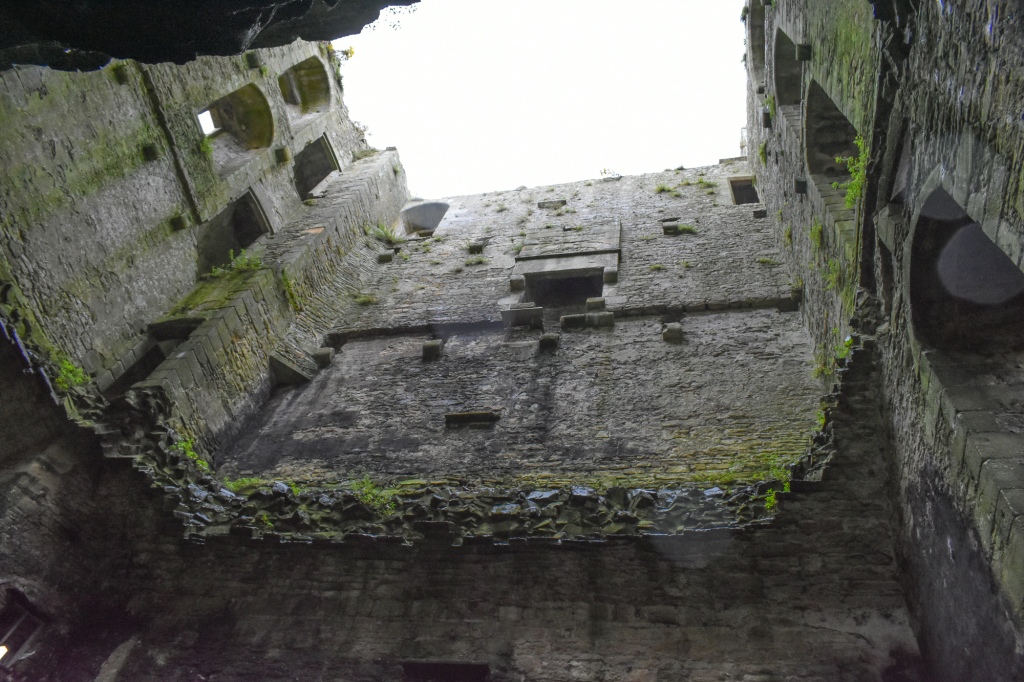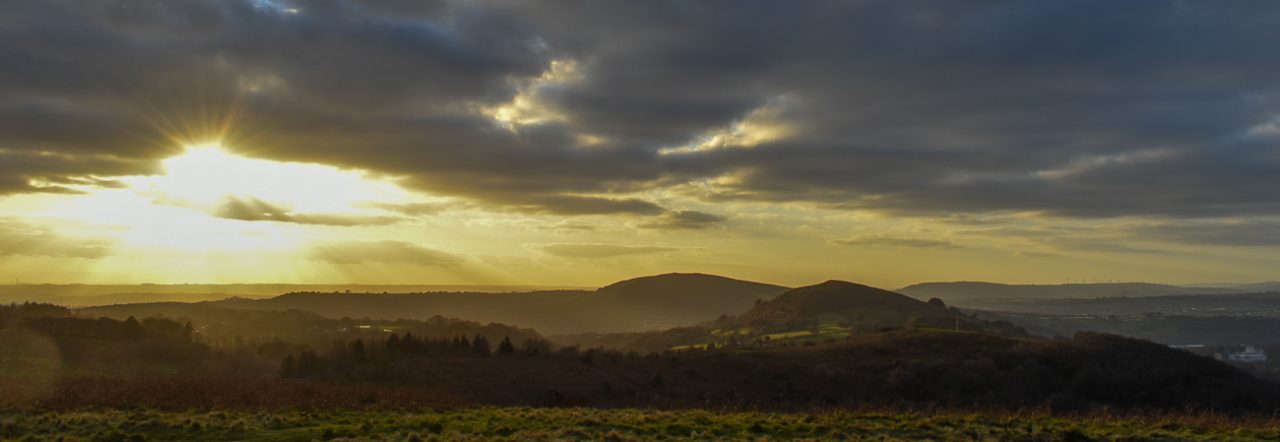
We spent a few days with my brother, Steve, and his wife, Alison, in the Yorkshire Dales. On one of the days, we ventured out in the rain to visit Bolton Castle, a place we’d never visited even though Valerie and I lived in the area for some years.

The castle, situated next to the village of Castle Bolton, was built by Sir Richard, 1st Lord of Scrope, starting in 1379 and was finished in 1399. It’s reached by driving, very carefully, along a narrow road off the winding country road leading from Redmire to Carperby, just north of Aysgarth. There, the famous falls tumble over small rocky platforms as the River Ure runs on its way to join the River Swale not far from Boroughbridge. These two rivers flow into the River Ouse that runs through York until it forms part of the wide estuary of the River Humber and eventually pours into the North Sea off the east coast of England. You’ll find a Google map here.
The car park is just west of the castle and the daily charge was £4 in August 2019, £3 of which is refunded if you pay for entry into the castle. Walkers use it to explore the local Dales countryside, reputed to be the best walking country in Europe; an assessment with which I fully concur.
There were few cars there as we arrived. There’s a public loo on the car park for visitors. And a relatively short walk down the road through the village will take you to the Bolton Arms should you feel like some refreshment.

I’ll give you a potted history of the castle before I go on to describe the place and the visit, as I’m writing this to guide those who’d like to visit and to inform and entertain those who’ll never make it.
The castle was more than a defensive stronghold; it was a luxury home that broadcast the status and royal approval of the family at the time. In 1536, the 8th Baron Scrope managed to upset Henry VIII and the castle was ‘fired’ as a result, suffering major damage. And in 1647 it was ‘slighted’ and left militarily useless by Oliver Cromwell’s forces following a 6-month siege when the family backed the wrong side in the Civil War.

Nearby Bolton Hall became the new home of the family in 1675 and in 1761 the North East Tower collapsed during a damaging storm.
Just before the end of 1999, extensive conservation work was completed to make the castle accessible for visitors. And today virtually the whole castle remains open to the public from 1st April to 3rd November, charging £9.00 per adult for entry to the building and the gardens, £7.50 for ‘concessions’ which include derelicts over 60 (that was us) and children aged 5-18 (younger ones get in free).
On entry, you’re given a useful sheet giving details of the history and how to make the most of your time, along with a single sheet plan detailing each of the five floors of the remains. This is a handy guide, which together with the many information boards throughout the grounds, gives a lot of facts.

You enter on the 1st floor (for US readers, this means the floor that’s level with the road outside) and collect your tickets from the gift shop which is through the Tea Rooms (of which more later). The advice is that you go first to the Courtyard, a wide-open area in the centre of the castle giving access to several rooms on the ground floor.

Having arrived here in wind-blown drizzle, we were glad to get under cover. As we ventured back out we were pleased to discover the rain had stopped, for a while.

We visited the Armourer’s Workshop, where various replica weapons from the Wars of the Roses (a civil war) in the late 15th century are displayed. You’d have to be fit and strong to wield those swords and pikes! The wealthy could afford the solid armour needed to avoid sudden death from the powerful longbows in use at the time. The peasantry, often forced into acting as foot soldiers, had to make do with whatever protection they could muster and were therefore more likely to be killed than their masters.

From there we entered the Threshing Floor, where a pony or donkey would have been bound to the grinding wheel to make flour from the grain, tended by a single man; probably the most boring job imaginable, as the poor beast of burden walked in a small circle without halt all day.

The Brew House is where the beer was made. Here, you’ll find an info board giving information about ‘small beer’ being used as a substitute for polluted water. However, I suggest you take that story with a pinch of salt, as there’s evidence that water was commonly consumed at the time. Whilst some water was polluted through poor sanitation it wasn’t considered to be unhealthy as a drink; the reality was that it generally tasted foul. The brewing process rendered the liquid more palatable and provided an energy source. Many people, including infants, drank beer; but usually from choice rather than because of fear of disease, which wasn’t suspected as water-borne until Dr John Snow produced evidence of its cause of Cholera in London in 1856. Before that time, it was widely considered that the smell of bad water caused disease.

The Bake House, with its large open fire, fed the bread ovens behind. The bread was covered with red hot embers that burnt the bottom of the loaf but left a relatively clean and tasty ‘upper crust’ which was reserved only for the wealthiest. This process is considered to be the origin of the expression relating to the high-born in use today. However, the evidence on this is somewhat different, with the earliest reference to the upper crust in relation to people is from 1823, when it was considered low slang.

With the Provender House, full of food, and the Kneading and Proving room, always a warm space to allow the bread to rise, doing their specialist jobs, the whole area was no doubt popular for its heat in the winter and the appetising smells throughout the year.

Next door is the Guard Room, all that’s left of the South East Tower. Above it would have been the Garrison Mess Hall, which gave access to half a dozen accommodation chambers.


I’ll end this post here, before it grows too long, and post the second half of the account in the next couple of days.



Hubs and I took a hiking vacation in the Dales many years ago, staying at a sheep farm. We didn’t see Bolton Castle though – as I recall, Mary Queen of Scots was held there for a while. What a great place to visit!
LikeLiked by 1 person
Yes, Noelle, a great place to visit. We not only walked the Dales, but lived in Settle for a while. But it took this visit to see my brother before we visited the castle.
I mention Mary, Queen of Scots, in the second part of the post, now posted. Enjoy!
LikeLiked by 1 person
Informative and well written. Well worth a visit even if you are a peasant!!
LikeLiked by 1 person
Thanks, Steve. We peasants must stick together!
LikeLike
I love places like this. Thanks for the history as well.
LikeLiked by 1 person
Thanks, Darlene. You’re welcome!
LikeLiked by 1 person